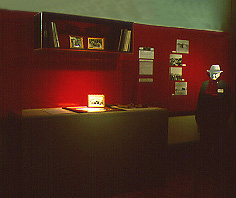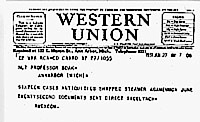The collection was begun in 1893 by Francis W. Kelsey, a professor of Classics at the University of Michigan, who purchased ancient lamp fragments (see below) to show to his students.
Pay no attention to that man in the corner.

One of the aims of "Caught Looking" is to show the Kelsey Museum
not as an anonymous and timeless institution but as one that changes over
time with the people who visit and work in it. This page explores some of
these multiple perspectives.
How might an "experimental exhibit" look twenty years from now?
The collection was begun in 1893 by Francis W. Kelsey, a professor of Classics at the University of Michigan, who purchased ancient lamp fragments (see below) to show to his students. Pay no attention to that man in the corner. |
 |
Problems of provenance
More on F.W. Kelsey and the early University of
Michigan excavations
Directory
1.The area, sphere, or group in which something has originated or from which it is derived; source; provenience.
The Kelsey Museum houses 101,668 objects, acquired by gift, purchase,
and excavation.
Since F.W. Kelsey's time, the museum collection has undergone many changes,
reflecting not only the different styles and personalities of its curators,
but also the evolving nature of archaeology.
 |
For example, unprovenanced objects --like these lamps and terracottas which Kelsey amassed-- are still an important part of the museum's collection. However, some modern students of archaeology would argue that since we do not know where the objects were found, essential information about their ancient owners and their patterns and dates of use in antiquity is lost. |
Others might argue that unprovenanced objects provide vital information, illustrating the wide variety of forms, decoration, and manufacture in which objects were produced in the ancient world.
| Go Back |
Professor Kelsey was also responsible for the University of Michigan
excavations at Karanis, Egypt. (From a memorandum to the U.of M. Committee on Near East Research.) |
|
Scroll down to see images from the U.M. excavations
in Egypt from early in this century.
Go Back
 |
Telegram from Professor Kelsey, "FOUND HORAD [sic] SIXTY MINTPERFECT GOLD COINS SECOND CENTURY PLEASE INFORM CONFIDENTIALLY RACKHAM AND COMMITTEE..." |
||
 |
Telegram from Cairo to Ann Arbor, "SIXTEEN CASES ANTIQUITIES |
||
| More images |
|
|
|
|
| Directory |